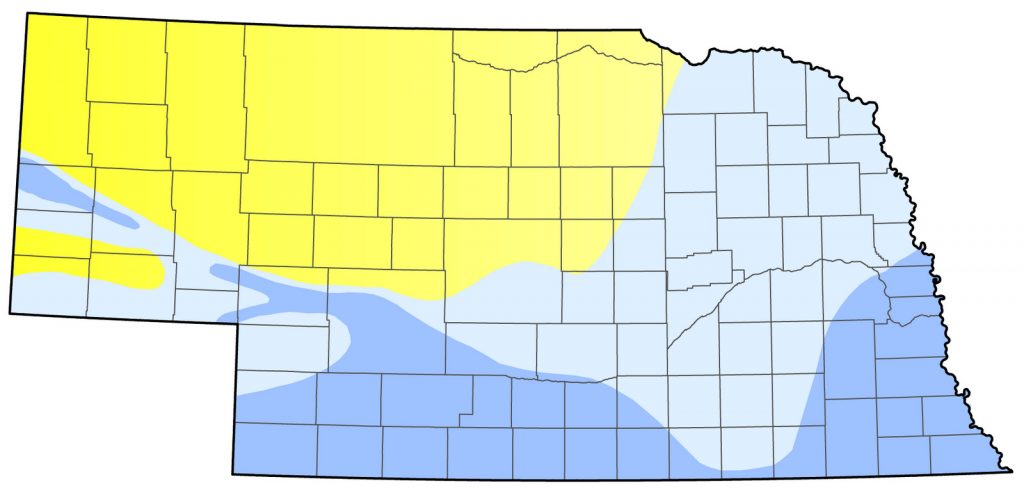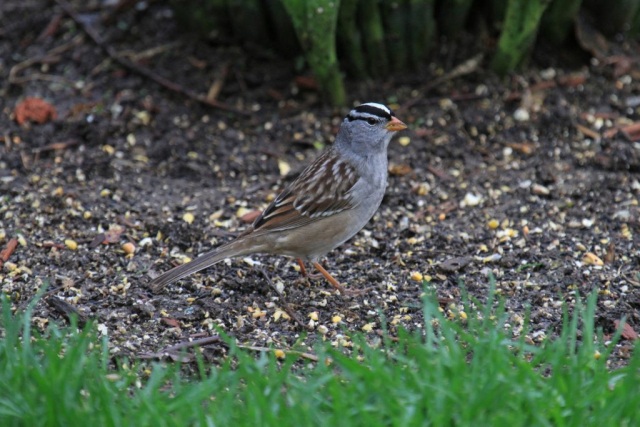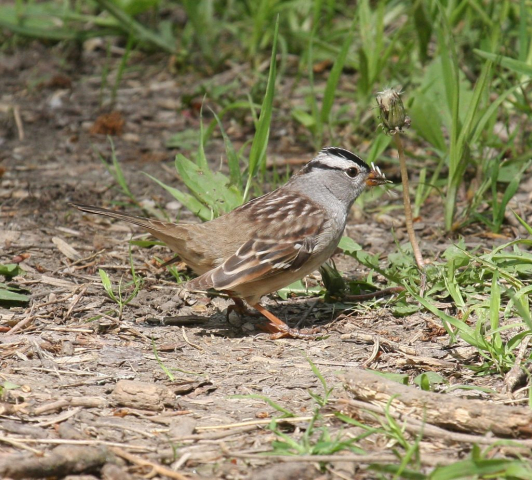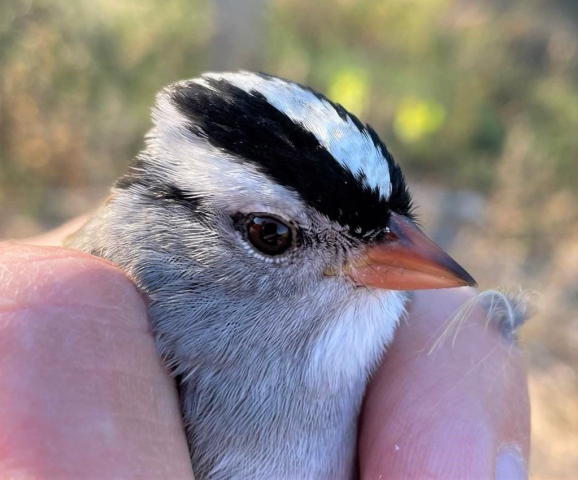Zonotrichia leucophrys leucophrys, Z. l. gambelii, Z. l. oriantha
Status: Common regular spring and fall migrant west and west-central, fairly common elsewhere. Rare casual summer visitor statewide. Common regular winter visitor west, uncommon south and southeast, rare northeast, rare casual north.

Documentation: Specimens: gambelii, UNSM ZM7489, 19 Apr 1890 Crete, Saline Co; leucophrys, UNSM ZM7484, 3 May 1902 Lancaster Co; oriantha, UNSM ZM7494, 23 Jun 1916 Scotts Bluff Co.
Taxonomy: Five subspecies are recognized (AviList 2025): gambelii, breeding from Alaska to British Columbia to Northwest Territories and northern Manitoba, wintering to California and Texas, pugetensis, breeding in coastal British Columbia to northwest California, wintering coastal southwest California, nuttalli, resident coastal central California, oriantha, breeding in montane southwest Alberta to eastern California and northwest New Mexico, wintering to southern California and southwest Texas, and leucophrys, breeding from Ontario to Newfoundland, wintering from Kansas south to Texas and east to Maryland and Florida.
Most Nebraska migrants and winter visitors are the pale-lored subspecies gambelii, which occurs statewide as a migrant, wintering primarily in the Panhandle. Two dark-lored subspecies, leucophrys and oriantha, occur in the state; although their breeding ranges do not overlap, they probably cannot be separated in the field, or even in the hand (Tony Leukering, post to COBIRDS 2006; Wright 2019).
Based on breeding range, leucophrys (black lores, pinkish bill; Dunn et al 1995) would be expected in the east and east central as a migrant; Mark Brogie (personal communication) noted in the Creighton, Knox Co area black-lored birds are usually more common than pale-lored. In South Dakota gambelii and leucophrys occur in equal numbers in the extreme east while gambelii is more frequent elsewhere (Tallman et al 2002). Ludlow (1935) considered both subspecies common spring migrants in Webster Co, and Tout (1947) indicated that both occur in Lincoln Co, although gambelii was “the commoner”. eBird maps (accessed Dec 2024) show leucophrys as essentially a spring and fall migrant in eastern Nebraska with a total of 45 reports.
Subspecies oriantha breeds in the Rocky Mountains, including the Laramie Mountains of Wyoming, and departs in fall (Faulkner 2010). On the northeastern plains of Colorado (including Front Range locations) there are at least 30 fall reports of oriantha with modal arrival dates 7,8,8 Sep and modal departure dates 15,15,16 Oct (eBird.org, accessed Dec 2023). There are only four later dates, two without details 22 and 30 Oct, and two with photos 22 and 23 Oct showing a thin black loral line (eBird.org, accessed Dec 2023). Thus, it is highly likely dark-lored birds on the eastern Colorado plains after Oct are leucophrys. Indeed, it was pointed out by Faulkner (2010) that dark-lored birds on the eastern plains of Wyoming in late fall and winter “might be” leucophrys, rather than oriantha; Tony Leukering (post to COBIRDS 2006) noted that in Colorado oriantha departs the state for the winter and thus it was likely that the 1-2 dark-lored birds that he sees on the eastern plains every winter are indeed referable to leucophrys. Thus, two dark-lored birds in Scotts Bluff Co, Nebraska 22 Dec 2022, and singles in Hitchcock Co 9 Feb 2024 and Keith Co 21 Feb 2024 may have been leucophrys. Presumably spring migrants are mostly, if not all, oriantha; there are no Panhandle records of “dark-lored” birds before 25 Apr (eBird.org, accessed Jun 2024). The only spring record of oriantha for Nebraska is 15 May 2020 in Kimball Co, although there are two Jun records (see below). A single on 3 May and three on 8 May 2022 in Dundy Co may have been leucophrys; although while oriantha should be moving north on those dates, none were reported on the eastern Colorado plains until 13, 16 and 22 May in 2022 (eBird.org, accessed Dec 2024).
There are two Jun records of oriantha in western Nebraska, not far from the breeding range in Colorado and Wyoming: one was photographed at Crescent Lake NWR, Garden Co 18 Jun 2010 (Cory Gregory, eBird.org), and a male specimen UNSM ZM7494 was collected 23 Jun 1916 at Mitchell, Scotts Bluff Co (Mickel and Dawson 1920). The latter has a very dark reddish-brown bill, is as pale on the flanks as any other specimen in the UNSM collection and has extensive black coloration in the loral area which extends to the gape. Another specimen, UNSM ZM7483, is virtually identical to UNSM ZM7494. Cory Gregory (eBird.org) pointed out a difference in his 18 Jun 2010 record between oriantha and leucophrys where oriantha has “the lower white stripe ending at the front of the eye, not extending farther towards the bill as in Z. l. leucophrys“.
A complicating factor is the existence of a zone of intergradation between gambelii and leucophrys in northeastern Manitoba and eastward near Hudson Bay, where “intermediates … abound” (Chilton et al 2020); migrants associated with this zone may appear in Nebraska, presumably in the east. A possible intergrade was photographed in Lancaster Co 14 Oct 2021 (see photo herein).
White-crowned Sparrow hybridizes occasionally with other Zonotrichia species, Golden-crowned, Harris’s, and White-throated Sparrows, although none are recorded for Nebraska. Nearest are three hybrids with Golden-crowned Sparrow for Colorado and one of a hybrid with White-throated Sparrow for Iowa (eBird.org, accessed Dec 2023).
Spring: winter<<<>>> May 31, Jun 1, 1 (gambelii); Apr 23, 26, 27 <<<>>> May 12, 12, 13 (leucophrys)
For later Jun dates for gambelii, see Summer.
Earlier dates for leucophrys are 9 Mar-12 May 2025 Wayne, Wayne Co, 22 Mar 2023 Washington Co, 24 Mar 2023 Sarpy Co, 25 Mar 2025 Sarpy Co, 27 Mar 2021 Nemaha Co, 18 Apr 2025 Merrick Co, and 23 Apr 2025 Wayne Co.
A later date for leucophrys is 17 May 2025 Thurston Co.
Migration occurs mostly in late Apr-mid-May. There is a noticeable northward move into the southern Panhandle in May and eBird bar charts show increased reports mid-Apr through mid-May (eBird.org, accessed Dec 2023). Tout (1947) gave migration dates in Lincoln Co 2 Apr-26 May.
There are 11 Panhandle records of dark-lored birds, likely oriantha, 25 Apr-28 May (eBird.org, accessed Jun 2024).
- High counts: 275 at Lake McConaughy, Keith Co 29 Apr 1994, 219 in Hall Co 13 May 2006, 205 in Scotts Bluff Co 25 Apr 2022, 195 at Oliver Reservoir, Kimball Co 4 May 2024, and “hundreds” in Lincoln Co 30 Apr 2004.
Summer: There are several reports from the summer months (Jun-Jul), most from the northwest, but there is no evidence that this species has bred in Nebraska. It does not breed in the Black Hills of South Dakota (Tallman et al 2002) but does breed (oriantha) in the Laramie Mountains in eastern Wyoming (Faulkner 2010). Rosche (1982) listed White-crowned Sparrow only as a migrant in the northwest.
Jun-Jul records are 9 Jun 1919 Kimball Co (specimen, UNSM ZM7483), 9 Jun 2005 Scottsbluff, Scotts Bluff Co, 17 Jun Hastings, Adams Co (Swenk 1930), 18 Jun 2010 Garden Co, 23 Jun 1916 Scotts Bluff Co (specimen, possibly oriantha, UNSM ZM7494, Mickel and Dawson 1920), 24 Jun-1 Jul 1988 Dawes Co, 25 Jun 2004 Hall Co, and 25 Jun 2025 gambelii Buffalo Co.
Fall: Sep 3, 3, 4 <<<>>> winter (gambelii); Oct 4, 4, 4 <<<>>> Oct 21, 25, Nov 4 (leucophrys)
An earlier date is 30 Aug 2020 Kimball Co. Later dates for leucophrys are 13 Dec 2023 Sarpy Co and 18 Dec 2020 Dixon Co.
Migration is discernible by late Sep (eBird.org, accessed Dec 2023) with peak counts in late Sep and early Oct; Aug and early Sep reports are few. Tout (1947) gave migration dates in Lincoln Co 22 Sep-1 Nov. The last sighting in Lancaster Co in 2009 was 3 Nov and 14 Nov in 2011. Departure is difficult to determine as many birds linger into winter (see Winter).
There are 11 Panhandle records and one for Arthur Co of dark-lored birds, likely oriantha, 20 Sep-24 Oct (eBird.org, accessed 31 Dec 2023).
- High counts: 295 between Minatare and Lake Alice, Scotts Bluff Co (gambelii) 23 Oct 2023, 255 along Road 44, southeastern Garden Co 2 Oct 2020, 250 at Gilbert-Baker WMA, Sioux Co 15 Sep 2024, and 240 at Oliver Reservoir, Kimball Co 3 and 9 Oct 2024.
- 505 were tallied, including separate flocks of 170 and 145, between Lakes Minatare and Alice, Scotts Bluff Co 14 Oct 2021.
Winter: Most White-crowned Sparrows winter south of Nebraska, and so overwintering within the state is uncommon, except for the western North Platte River Valley. Winter reports are restricted to the west, south (Platte River Valley counties southward) and east. Wintering occurs regularly in the Scottsbluff area, where CBC counts are the highest for the state, including 446 in 2015 and 268 in 2016. CBC data since 1967 indicate that in Dec about 86% of birds reported were in the Panhandle, with almost all of the rest in the southeast. Rosche (1994) noted that in the northwest “there is always a marked decrease after long, severe cold spells after late January each year.”
In the north and northwest there are these midwinter (Jan-early Mar) reports: 1 Jan 1991 Sioux Co, an immature 2 Jan-6 Feb 2017 Knox Co, 5 Jan 1967 Custer Co, 5 Jan 2008 Albion, Boone Co, 12-13 Jan 1999 immature at Creighton, Knox Co, 15 Jan 1953 Dawes Co, 20 on 26 Jan 2008 Broken Bow, Custer Co, 30 Jan 2024 Fort Niobrara NWR, Cherry Co, 3 Feb 1960 Antelope Co, 7-16 Feb 2015 2-4 at various locations in Custer Co, 11 Feb 1983 Boone Co, two on 14 Feb 2015 Box Butte Co, 23 Feb 2025 (15) Antelope Co, 9 Mar 1957 Brown Co, and 10 Mar 1985 Sioux Co.
Subspecies leucophrys is an uncommon migrant in the east, with only these winter (Jan-Feb) records: 22 Jan 2024 Douglas Co, and 19 Feb 2022 Dakota Co.
- High counts: 90 from Minatare to Lake Alice, Scotts Bluff Co 14 Feb 2024, 62 at Broadfoot Sand and Gravel, Buffalo Co 15 Dec 2024, 61 at Benkelman, Dundy Co 19 Feb 2021, 60 near Gibbon, Buffalo Co 14 Jan 2024, and 60 along CR20, Scotts Bluff Co 22 Jan 2024.
Images
Abbreviations
CBC: Christmas Bird Count
NWR: National Wildlife Refuge
SRA: State Recreation Area
UNSM: University of Nebraska State Museum
Literature Cited
AviList Core Team, 2025. AviList: The Global Avian Checklist, v2025. https://doi.org/10.2173/avilist.v2025.
Chilton, G., M.C. Baker, C.D. Barrentine, and M.A. Cunningham. 2020. White-crowned Sparrow (Zonotrichia leucophrys), version 1.0. In Birds of the World (A. F. Poole and F. B. Gill, Editors). Cornell Lab of Ornithology, Ithaca, NY, USA. https://doi.org/10.2173/bow.whcspa.01.
Dunn, J.L., K.L. Garrett, and J.K. Alderfer. 1995. White-Crowned Sparrow subspecies: identification and distribution. Birding 27: 182-200.
Faulkner, D.W. 2010. Birds of Wyoming. Roberts and Company, Greenwood Village, Colorado, USA.
Ludlow, C.S. 1935. A quarter-century of bird migration records at Red Cloud, Nebraska. NBR 3: 3-25.
Mickel, C.E., and R.W. Dawson. 1920. Some interesting records of Nebraska birds for the year 1919. Wilson Bulletin 32: 73-79.
Rosche, R.C. 1982. Birds of northwestern Nebraska and southwestern South Dakota, an annotated checklist. Cottonwood Press, Crawford, Nebraska, USA.
Rosche, R.C. 1994. Birds of the Lake McConaughy area and the North Platte River valley, Nebraska. Published by the author, Chadron, Nebraska, USA.
Swenk, M.H. 1930. The Crown Sparrows (Zonotrichia) of the Middle West. Wilson Bulletin 42: 80-95.
Tallman, D.A., Swanson, D.L., and J.S. Palmer. 2002. Birds of South Dakota. Midstates/Quality Quick Print, Aberdeen, South Dakota, USA.
Tout, W. 1947. Lincoln County birds. Published by the author, North Platte, Nebraska, USA.
Wright, R. 2019. Sparrows of North America. Peterson Reference Guide. Houghton Mifflin Harcourt, Boston and New York.
Recommended Citation
Silcock, W.R., and J.G. Jorgensen. 2025. White-crowned Sparrow (Zonotrichia leucophrys). In Birds of Nebraska — Online. www.BirdsofNebraska.org
Birds of Nebraska – Online
Updated 29 Aug 2025



